NEET Physics Ray Optics and Optical Instruments Notes
Ray Optics and Optical Instruments
Laws of Reflection of Light:
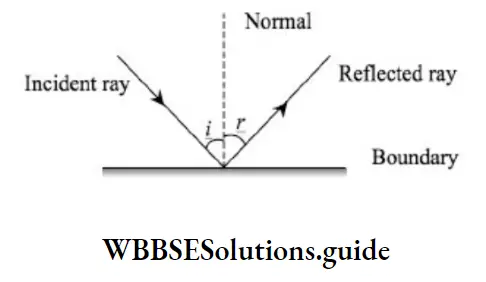
- The incident ray, reflected ray and the normal drawn at the point of incidence all lie in the same plane.
- Angle of incidence is equal to the angle of reflection.
Sign conventions:
- All distances are measured from the pole of the mirror.
- Distances measured in the direction of incident light are taken positive and vice versa.
- Heights measured upward and perpendicular to the principal axis are taken positive and vice versa.
Read And Learn More: NEET Physics Notes
For a spherical mirror, the relation between focal length and radius of curvature is,
\(\mathrm{f}=\frac{\mathrm{R}}{2}\)Where, f is the focal length and ‘R’ is the radius of curvature of the mirror.
Mirror equation
\(\frac{1}{f}=\frac{1}{u}+\frac{1}{v}\)Where u is the object distance and v is the image distance.
Linear magnification is the ratio of the height of the image to the height of the object.
\(\mathrm{m}=\frac{\mathrm{h}_{\mathrm{i}}}{\mathrm{h}_{\mathrm{o}}}\)For a spherical mirror, \(\mathrm{m}=-\frac{\mathrm{v}}{\mathrm{u}}\)
The refractive index of a medium is defined as the ratio of the speed of light in vacuum (c) to the speed of light of medium (v)
\(\mathrm{n}=\frac{\mathrm{e}}{\mathrm{v}}\)Refractive index of a medium depends on the wavelength of light used.
Longer the wavelength smaller is the refractive index.
Laws of refraction of light
- The incident ray, refracted ray and the normal drawn at the point of incidence all lie in the same plane.
- Sine of angle of incidence to the sine of angle of refraction is a constant for a given pair of media and for given wavelength of light.
Where is the refractive index of medium 2 w.r.to medium 1.
If \(n_{21}>1, \mathrm{r}<\mathrm{i} \text { and if } n_{21}<1, \mathrm{r}>\mathrm{i}\)
Expression for normal shift
N. S .= \(t\left(1-\frac{1}{n}\right)\)
where t is the thickness and n is the refractive index of the medium.
Relation between refractive index and critical angle
\(\sin \mathrm{C}=\mathrm{n}_{21}=\frac{\mathrm{n}_2}{\mathrm{n}_1}\)Where ‘C’ is the critical angle
Relation between n, u, v, and R for a spherical refracting surface.
\(\frac{\mathrm{n}_2}{\mathrm{v}}-\frac{\mathrm{n}_1}{\mathrm{u}}=\frac{\mathrm{n}_2-\mathrm{n}_1}{\mathrm{R}}\)Where, n2 is the refractive index of the image medium.
n1 is the refractive index of the object medium.
And R is the radius of curvature.
Lens maker’s formula
\(\frac{1}{\mathrm{f}}=\left(\mathrm{n}_{21}-1\right)\left(\frac{1}{\mathrm{R}_1}-\frac{1}{\mathrm{R}_2}\right)\)Thin lens formula
\(\frac{1}{v}-\frac{1}{u}=\frac{1}{f}\)Magnification produced by a lens
\(\mathrm{m}=\frac{\mathrm{v}}{\mathrm{u}}\)Power of a lens
\(P=\frac{1}{f}\)The S.I. unit of power of a lens is dioptre (D)
1D = 1m¯¹
Combination of thin lenses in contact
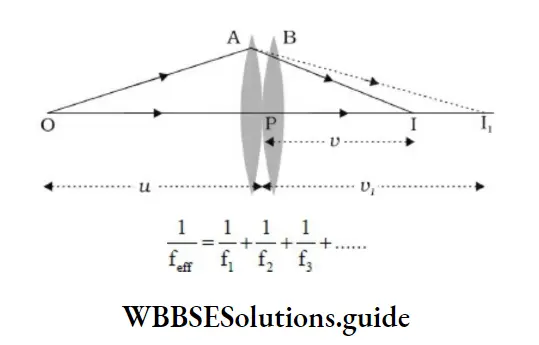
In terms of power,
Peff = P1 + P2 + P3 + ….
In terms of magnification,
Meff = m1. m2 . m3…..
Refraction through a prism
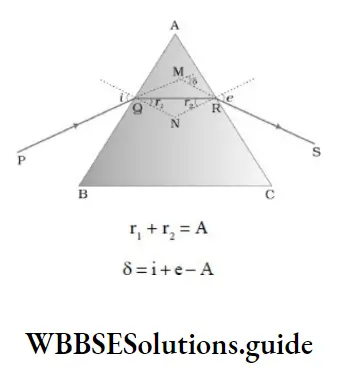
At the angle of minimum deviation
\(\begin{aligned}& \delta=\mathrm{D}_{\mathrm{m}}, \mathrm{i}=\mathrm{e} \Rightarrow r_{\mathrm{i}}=r_2 \\
& \Rightarrow \mathrm{r}=\frac{\mathrm{A}}{2} \\
& \mathrm{D}=\frac{\left(\mathrm{A}+\mathrm{D}_{\mathrm{m}}\right)}{2} \\
& \mathrm{n}_{21}=\frac{\mathrm{n}_2}{\mathrm{n}_1}=\frac{\sin \left(\frac{\left(\mathrm{A}+\mathrm{D}_{\mathrm{m}}\right)}{2}\right)}{\sin \left(\frac{\mathrm{A}}{2}\right)}
\end{aligned}\)
For a small-angle prism,
\(\begin{aligned}& \mathrm{n}_{21}=\frac{\frac{\left(\mathrm{A}+\mathrm{D}_{\mathrm{m}}\right)}{2}}{\left(\frac{\mathrm{A}}{2}\right)} \\
& \& \mathrm{D}_{\mathrm{m}}=\left(n_{21}-1\right) \mathrm{A}
\end{aligned}\)
In the above set of equations i is the angle of incidence, e is the angle of emergence, A is angle of prism & are angle of refractions at two boundaries, is deviation and Dm is angle of minimum deviation.
According to Rayleigh’s law of scattering if the particle size is greater the then,
Scattering is proportional to \(\frac{1}{\lambda^4}\).
Standard value of near point of human eye is D = 25 cm.
Magnification produced by simple microscope when image is produced at near point,
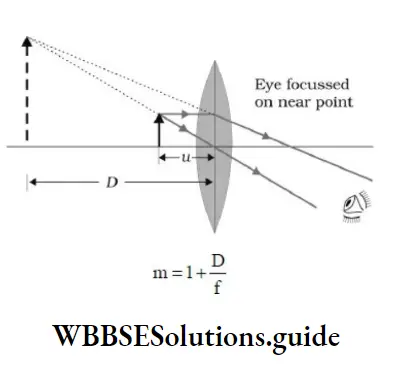
When the image is formed at infinity,
\(m=\frac{D}{f}\)Magnification produced by a compound microscope when image is formed at infinity is,
\(\begin{aligned}& m=m_0 m_e \\
& m=\left(\frac{L}{f_0}\right)\left(\frac{D}{f_e}\right)
\end{aligned}\)
Magnification produced by a compound microscope when image is formed at near point is,
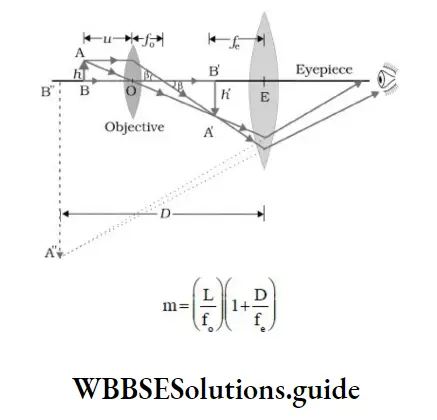
Where, and are the magnification of the objective and eyepiece respectively fo and fe are the focal lengths of the objective and the eyepiece respectively.
Magnification of the telescope is given by,
\(m=\frac{f_o}{f_o}\)where fo and fe are the focal lengths of objective and eyepiece respectively.
Magnifying power of a telescope is the ratio of the angle subtended at the eye by the image to the angle subtended at the eye by the object
\(\text { i.e., } \mathrm{m}=\frac{\beta}{\alpha}\)
